Datebook: Lavish life in Renaissance courts, a history of body ink and unseen Irving Penn
Summer is rapidly winding down, but there are still openings to be caught around town — including a look at glittering Renaissance life and and a show that is all about tattooing. Here are five exhibitions and events to check out in the coming week:
“All that Glitters: Life at the Renaissance Court,” at the Getty Museum. No group in history has quite done bling like the Renaissance elite: there was gleaming armor, rich textiles, monarchs draped in brocaded everything — not to mention architecture studded with gleaming stained glass and other luxuriant details. This exhibition gathers illuminated manuscripts, paintings, drawings, household articles and accessories that convey the richness of life in a Renaissance court. Get ready for some serious shine! Through Dec. 2nd. 1200 Getty Center Dr., Brentwood, Los Angeles, getty.edu.
Enrique Ramirez, “Un hombre que camina,” at the Grand Central Art Center. The Chilean-born artist is showing a new single-channel video that dwells, in rather magical ways, on issues related to migration and the ways in which globalism and digital life have connected once-disparate realms. Opens Saturday at 7 p.m. and runs through Nov. 11. 125 N. Broadway, Santa Ana, grandcentralartcenter.com.

“Ink,” at the Museum of Latin American Art. A new exhibition brings together various histories of tattooing in L.A. — including those inspired by military culture, Chicano tattooing and other historic forms. This will be presented alongside works from the permanent collection that connect with the theme of tattooing. Through Feb. 3. 628 Alamitos Ave., Long Beach, molaa.org.
Irving Penn, “Worlds in a Small Room, Seen & Unseen,” at Fahey / Klein Gallery. A solo exhibition of the influential photographer’s work brings together ethnographic studies undertaken during journeys to Peru, Morocco and New Guinea, among other locations. This will include a mix of well-known and previously unexhibited works. Opens Friday and runs through Oct. 6. An opening reception will be held on Sept. 6 at 7 p.m. 148 N. La Brea, Hancock Park, Los Angeles, faheykleingallery.com.

Nicole Reber and Eric Wiley, “You Just Never Know Who Somebody Is,” at These Days. A pair of artists from opposing coasts play with pop and surrealism in drawings, paintings and text works. Through Sept. 16. 118 Winston St., downtown Los Angeles, thesedaysla.com.
LAST CHANCE
“Selected Affinities,” at Christopher Grimes Gallery. A group show looks at the ways artists such as Allan Sekula, Connie Samaras, Miles Coolidge and others employ photography to describe aspects of human relations — such as Coolidge’s images of cargo containers transformed into migrant housing and a series by Sekula that examines the decline of fishing in a Spanish village. Particularly worthwhile is a video in the back room by Billy Woodbury that explores the lives of black dockworkers in Marseilles, France, in the years after World War II. Through Friday. 916 Colorado Ave., Santa Monica, cgrimes.com.

“Maiden L.A.” in locations around Los Angeles. A county-wide survey, whose name riffs on the Hammer Museum’s “Made in L.A.” biennial, brings together happenings in small and under-the-radar spots where the vibe is more D.I.Y. than corporate art world. The programming includes a full roster of other art and performance events. Through Friday. See the website for a full schedule of listings and locations. maiden.la.
Elizabeth Withstandley, “The Symphony of Names: No Man is an Island,” at Winslow Garage. In a collaboration with Icelandic composer Gunnar Másson, Withstandley has created a video installation that dwells on the nature of place and names: A boy travels through the Icelandic countryside as an audio track comprising all 4,129 names from the government names list serves as melodic backdrop. Through Friday. By appointment only. 3540 Winslow Drive, Silver Lake, Los Angeles, winslowgarage.com.
Jonny Negron, “Small Map of Heaven,” at Château Shatto. Born in Puerto Rico and based in New York, Negron has long been inspired by the bright colors and sharp lines of comic books and Japanese woodblock prints. But he employs the forms in ways that are resolutely his own, creating intimate scenes that also feature aspects of the fantastical — such as lush landscapes and ghostly figures. Through Saturday. Bendix Building, 1206 Maple Ave., downtown Los Angeles, chateaushatto.com.
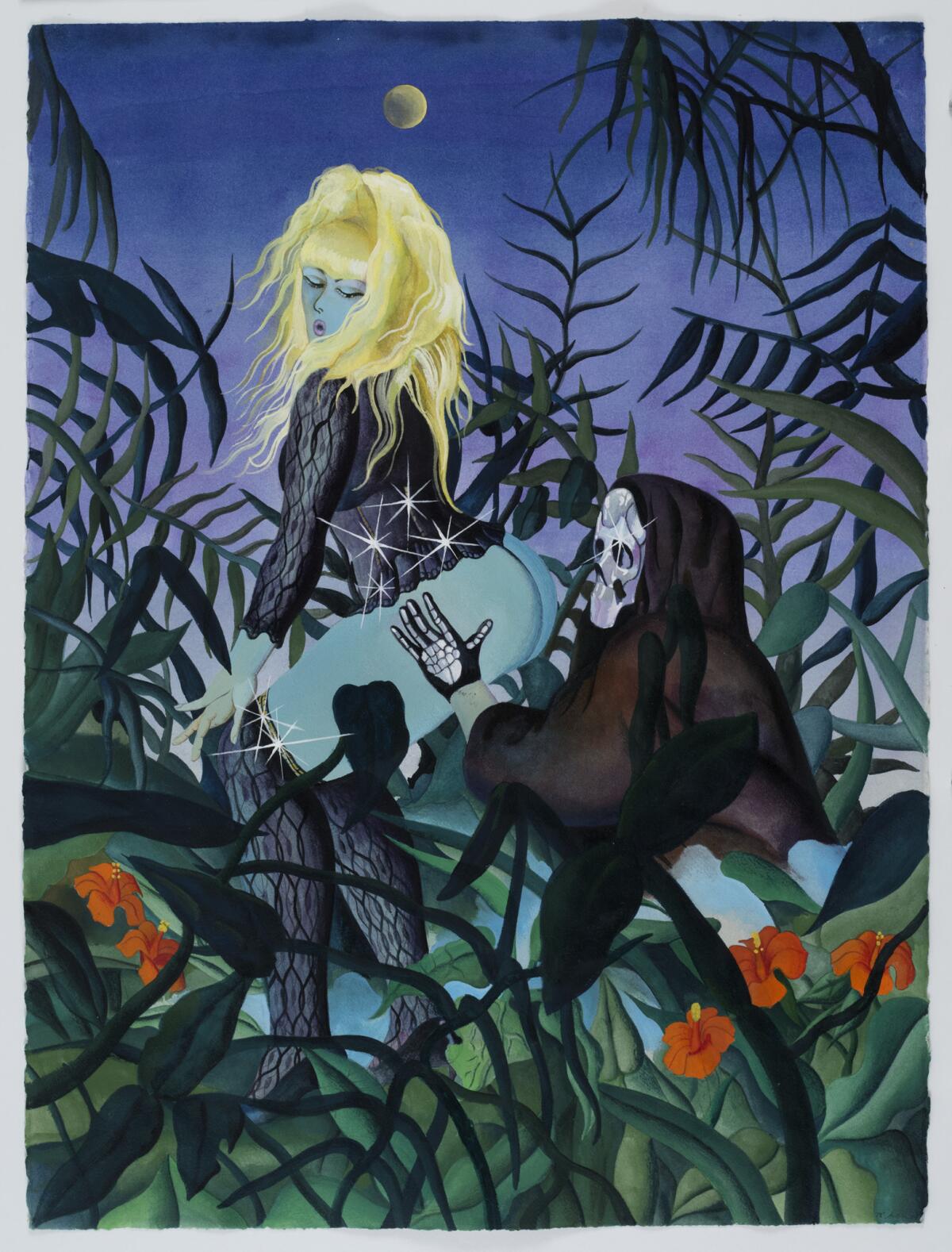
Sadie Barnette, “Dear 1968, ...” at the Museum of Contemporary Art San Diego. Barnette and her family recently obtained the 500-page file the FBI had amassed on her father, Rodney Barnette, during his time in the Black Panthers. The artist employs documents from the file along with other family objects as a point of inspiration for an installation that explores the intersection of the personal and the political in dramatic ways. Through Sunday. 1100 Kettner Blvd., San Diego, mcasd.org.
“Made in L.A. 2018,” at the Hammer Museum. It is the fourth edition of the Hammer’s always intriguing biennial and this year’s show, organized by Anne Ellegood and Erin Christovale, has brought together a wide-ranging group of artists, ages 29 to 97, exploring an even wider range of techniques, ideas and materials. This includes conceptual photographs by John Houck and Daniel Joseph Martinez, an ancient Egyptian-inspired temple by Mohn Award-winner Lauren Halsey, wry videos by Alison O’Daniel and Gelare Khoshgozaran, a vast lobby mural by Eamon Ore-Giron and some incredible paintings of the female body — as seen by female artists — by Christina Quarles, Linda Stark and Luchita Hurtado. And that’s just the beginning. Times art critic Christopher Knight describes the show as the best Hammer biennial yet. Do. Not. Miss. Through Sunday. 10899 Wilshire Blvd., Westwood, Los Angeles, hammer.ucla.edu.
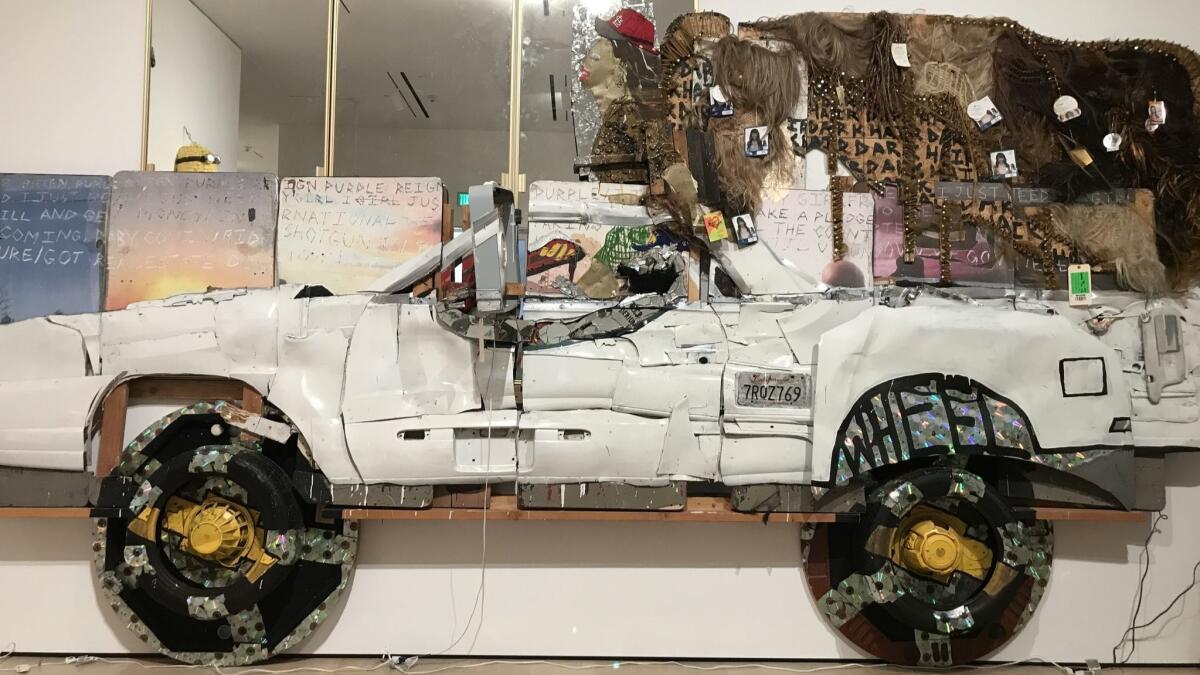
“This Brush for Hire: Norm Laich and Many Other Artists,” at the Institute of Contemporary Art, Los Angeles. Artists have long relied on fabricators to do everything from preparing materials to executing their work. This exhibition at the ICA LA looks at the work of one of those indispensable craftsmen: Norm Laich, who has helped produce iconic works for a range of Los Angeles artists, including Ed Ruscha, Paul McCarthy and Barbara Kruger. The show includes a range of signage, wall paintings and installations and will include a short documentary film on his life and work. An intriguing, generous look at an unnamed artist behind the art. Through Sunday. 1717 E. 7th St., downtown Los Angeles, theicala.org.
Skidmore, Owings & Merrill, “Poetic Structure: Art + Engineering + Architecture,” at the Mak Center for Art and Architecture. A specially built 27-foot long pavilion, which can be shaped and reshaped by human hands, will be used to display more than 30 scale models of the firm’s most recognizable buildings. Through Sunday. Schindler House, 835 N. Kings Road, West Hollywood, makcenter.org.
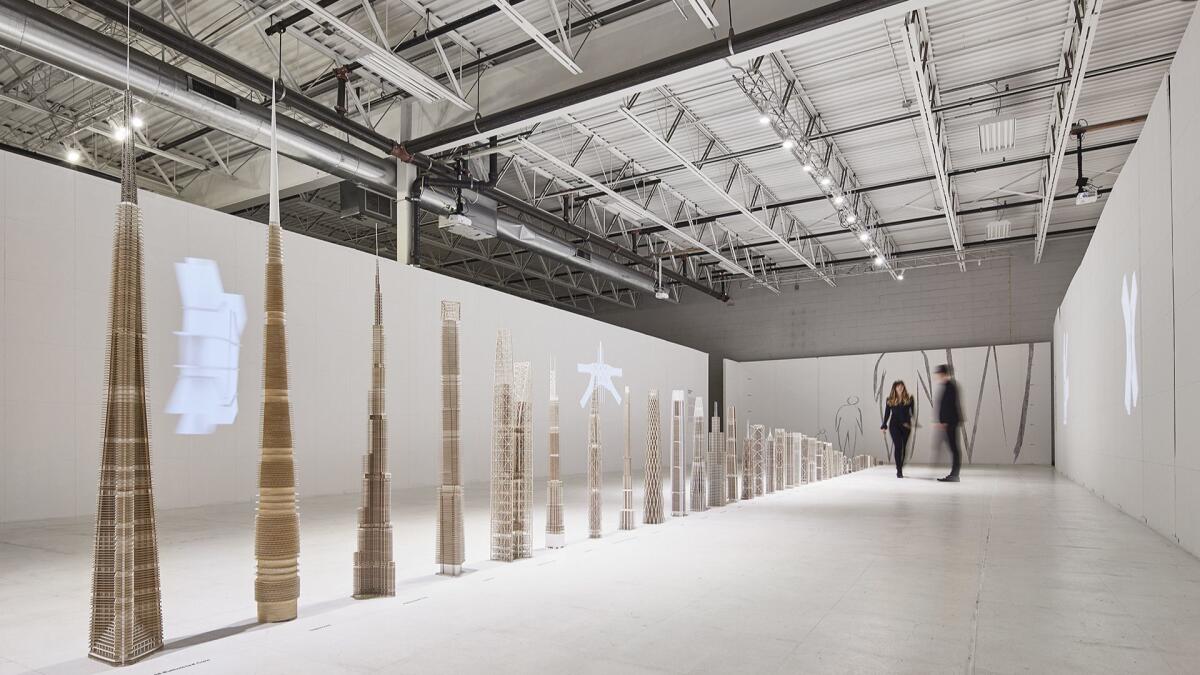
Lauren Halsey, “we still here, there” at the Museum of Contemporary Art. The artist has built a fantastical immersive environment inside the museum’s Grand Avenue location inspired by aspects of Afrofuturism and colloquial signifiers of black identity — a clever reimagining of the white cube. Through Monday. MOCA Grand Avenue, 250 S. Grand Ave., downtown Los Angeles, moca.org.
“City and Cosmos: The Arts of Teotihuacan,” at the Los Angeles County Museum of Art. In its day, the ancient city of Teotihuacan was the largest urban center in the Americas — and the sixth-largest city in the world. Today, it is an iconic Mexican archaeological site. This exhibition presents recent findings from excavations at the site’s three main pyramids. It includes more than 200 objects that help tell the story of the ancient city, including monumental sculpture and smaller-scale objects such as precious stones. Through Monday. 5905 Wilshire Blvd., Mid-Wilshire, Los Angeles, lacma.org.
“How They Ran,” at Over the Influence. A group show brings together a group of Los Angeles artists from different backgrounds and generations to reflect on the nature of the city they live and work in. This includes work by figures such as Uta Barth, Lisa Anne Auerbach, Jo Ann Callis, Kim Schoenstadt, Kerry Tribe and Monique Prieto, among many others. Through Wednesday. 833 E. 3rd St., downtown Los Angeles, overtheinfluence.com.

ONGOING
“Pussy, King of the Pirates,” at Maccarone. Inspired by the title of a Kathy Acker novel, this exhibition features work by 20 non-male artists who explore issues of the body, identity and gaze. This includes work by Eleanor Antin, Lisa Anne Auerbach, Sadie Barnett, Monica Majoli, Alison Saar and Sharon Lockhart — an all-star lineup. Through Sept. 8. 300 S. Mission Road, Boyle Heights, Los Angeles, maccarone.net.
Shinique Smith, “Refuge,” at California African American Museum. The multimedia artist is known for her bulbous assemblages crafted from old clothing and fabric, which she twists and ties and suspends from gallery ceilings and walls. Her paintings echo these bound and squeezed forms. Her first solo show at CAAM brings together works that evoke questions of homelessness and itinerancy. Through Sept. 9. 600 State Drive, Exposition Park, Los Angeles, caamuseum.org.
“Bamboo,” at the Craft and Folk Art Museum. Bamboo baskets are often thought of purely as functional objects: vessels that contain and transport food and household goods. An exhibition at CAFAM, however, explores bamboo basketry’s sculptural possibilities — including a large-scale bamboo installation inspired by mathematics (such as Fibonacci’s sequence and the Golden Ratio) by Japanese architect Akio Hizume. Through Sept. 9. 5814 Wilshire Blvd., Mid-Wilshire, Los Angeles, cafam.org.
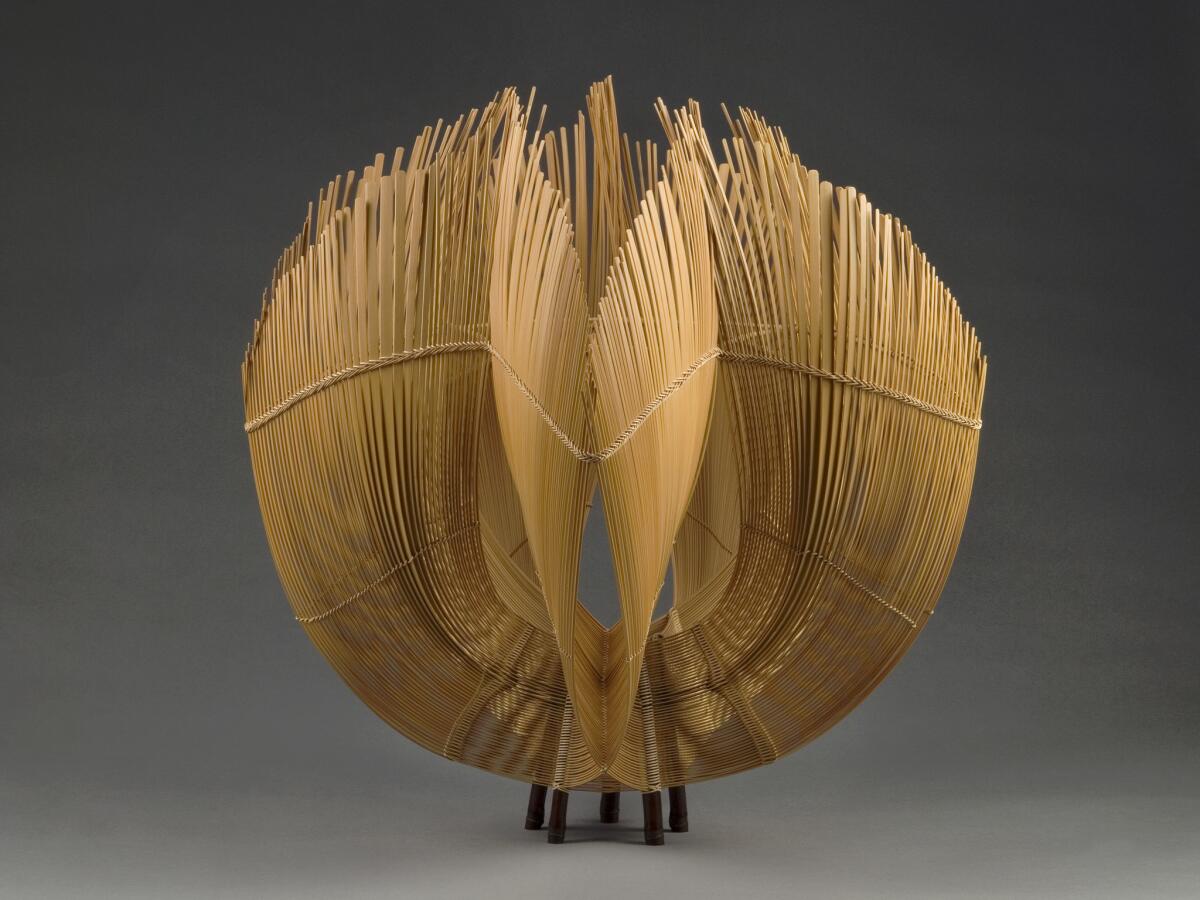
“Charting the Terrain: Eric Mack and Pamela Smith Hudson” at the California African American Museum. A pair of artists explore aspects of Western landscape through abstraction. In his work, Mack creates intricate compositions that echo aspects of movement and the urban grid, while Hudson’s works evoke the topographic — mapping devastation and rejuvenation. Through Sept. 9. 600 State Drive, Exposition Park, Los Angeles, caamuseum.org.
“Beyond the Nile: Egypt and the Classical World,” at the Getty Museum. This exhibition at the Getty explores the cultural connections between Greece, Rome and Egypt through more than 200 rare objects — many on view in the U.S. for the first time. The show spans more than 2,000 years, from the Bronze Age to the late Roman Empire and includes stone vessels, pottery, sculpture, portraits and religious imagery. It also includes a more than 15-foot granite obelisk from A.D. 88-89 inscribed to the goddess Isis and the emperor Domitian, on loan from the Museo del Sannio in Italy. Through Sept. 9. 1200 Getty Center Drive, Brentwood, Los Angeles, getty.edu.
Sidney B. Felsen, “The Artist observed,” at Gemini G.E.L. Felsen, a founder of the fabled print workshop Gemini G.E.L. has kept an extensive photographic archive of his time working with artists — including figures such as Robert Rauschenberg, Richard Serra, David Hockney, Tacita Dean and countless others. This exhibition presents images that he has snapped over the decades of artists at work and at play in the studio. Through Sept. 13. 8365 Melrose Ave., Beverly Grove, geminigel.com.

“When She Rises,” at SPARC. This group exhibition is showcasing works by several dozen female artists — including SPARC founder Judy Baca and myriad artists from across the U.S., such as Lorraine Jones, Nani Chacon, Ofelia Esparza, Sofia Maldonado, Erin Yoshi and Loveis Wise — all exploring issues of social justice related to equality and ecology. As part of the exhibition’s programming, there will be an arts and activism workshop and special screenings and panel discussions. Through Sept. 15. 685 Venice Blvd., Venice, whensherises.splashthat.com.
“Remote Castration,” at LAXART. A group exhibition uses the #MeToo and Time’s Up movements — and the ways in which they have drawn attention to abuses of power — as a way of reflecting on the ways in which feminist thought is addressed in contemporary art. The show will include work by figures such as Kathryn Garcia, Jenny Holzer, John Altoon and Paul McCarthy.Through Sept. 15. 7000 Santa Monica Blvd., Hollywood, laxart.org.
Todd Gray, “Portraits,” at Meliksetian Briggs. The Los Angeles artist, who recently received a prestigious Guggenheim Fellowship, is known for creating multimedia collages and assemblages that take photographic imagery from his own archive and then presents them in ways that comment on representations of blackness and the African diaspora. The work, part of his “Exquisite Terribleness” series, is centered on images of acquaintances and friends as well landscape and objects. Through Sept. 15. 313 N. Fairfax Ave., West Hollywood, meliksetianbriggs.com.
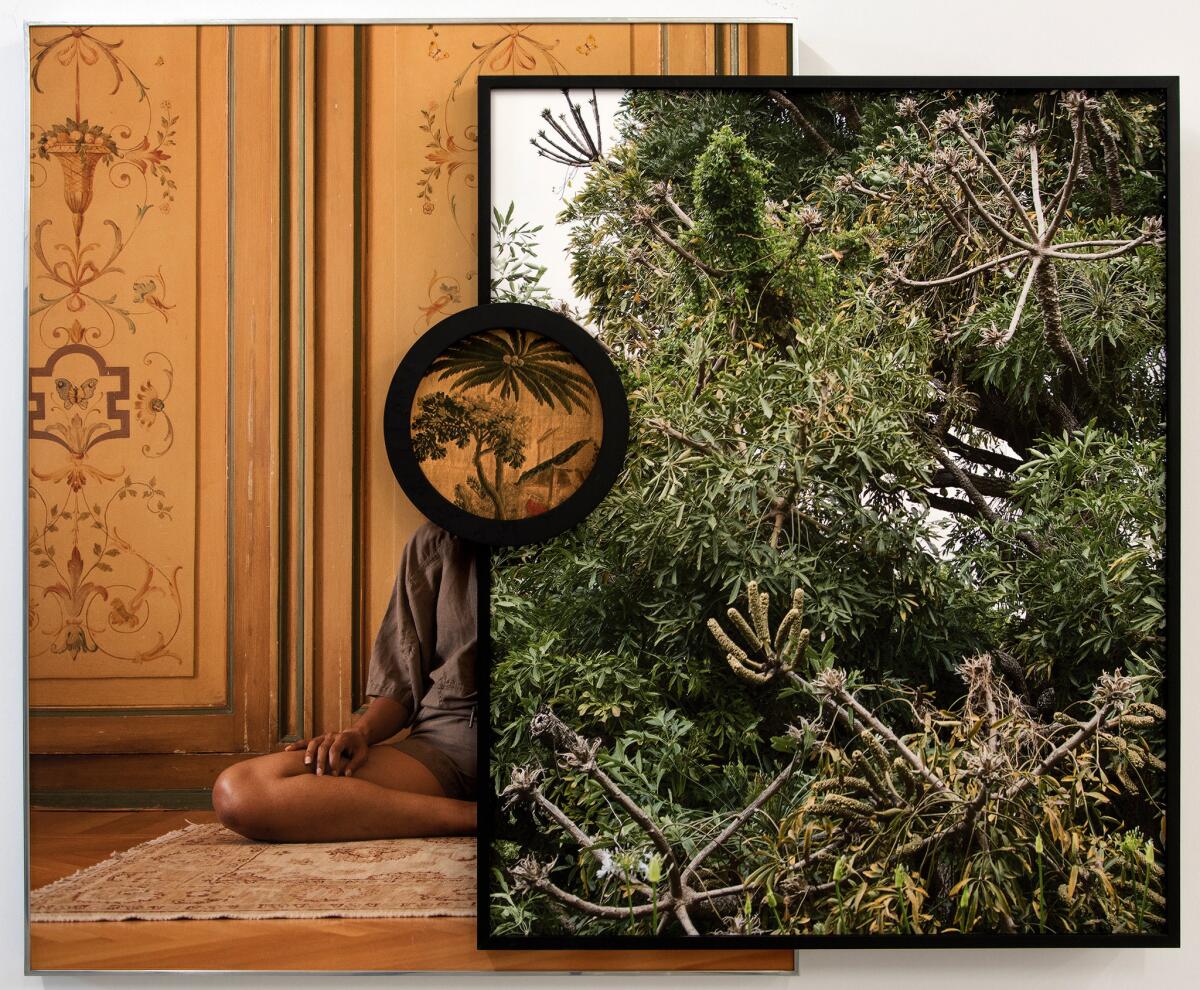
“My Veins Do Not End in Me,” at the Mistake Room. The show examines the Salvadoran Civil War through the work of artists from three generations of a single Salvadoran family: Eddie Rodolfo Aparicio, his father, Juan Edgar Aparicio, and his late grandmother Maria de la Paz Torres de Aparicio. Through Sept. 15. 1811 E. 20th St., downtown Los Angeles, tmr.la.
Nery Gabriel Lemus, “Yearning to Breathe Free,” at the Grand Central Art Center. In a series of detailed watercolor paintings Lemus explores migration and the dreams of those that seek to “breathe free” (in a nod to the famous Emma Lazarus poem, “The New Colossus”). Also on view will be sculptures and the painted rugs he makes in honor of individual migrants who perished attempting to realize that dream. Through Sept. 16. 125 N. Broadway, Santa Ana, grandcentralartcenter.com.
“Water and Power” at the Underground Museum. This is the latest collaboration between the artist-run space founded by late painter Noah Davis and the Museum of Contemporary Art Los Angeles. The show will feature a range of works by the likes of Olafur Eliasson, Robin Coste Lewis, Fred Eversley and Hans Haacke, among others. Through Sept. 16. 3508 W. Washington Blvd., Arlington Heights, theunderground-museum.org.

“Discovering Saar Ceramics,” at the American Museum of Ceramic Art. In 1949, artist Richard Saar and his brother William opened a ceramic studio in a small Quonset hut in El Segundo. Saar Ceramics, at its height, would go on to employ a staff of eight and produce functional and decorative pieces with elegantly rendered abstract designs and charming animal figures. Does the name sound familiar? Well, Saar was, for a time, married to key Los Angeles assemblagist Betye Saar in the 1950s and ’60s. Through Sept. 16. 399 N. Garey Ave., Pomona, amoca.org.
John Divola and Zoe Crosher, “Grounded,” at the El Segundo Museum of Art. In the 1970s, photographer John Divola explored the homes and other buildings that were condemned by an expansion of LAX airport in an area referred to as the Noise Abatement Zone. Thirty years later, Zoe Crosher captured the ways in which the airport makes its presence felt in daily life in the surrounding communities. This exhibition at ESMoA brings together dozens of their works, shot decades apart, for a unique view of a transitory space that marks the city in permanent ways. Through Sept. 22. 208 Main St., El Segundo, esmoa.org.
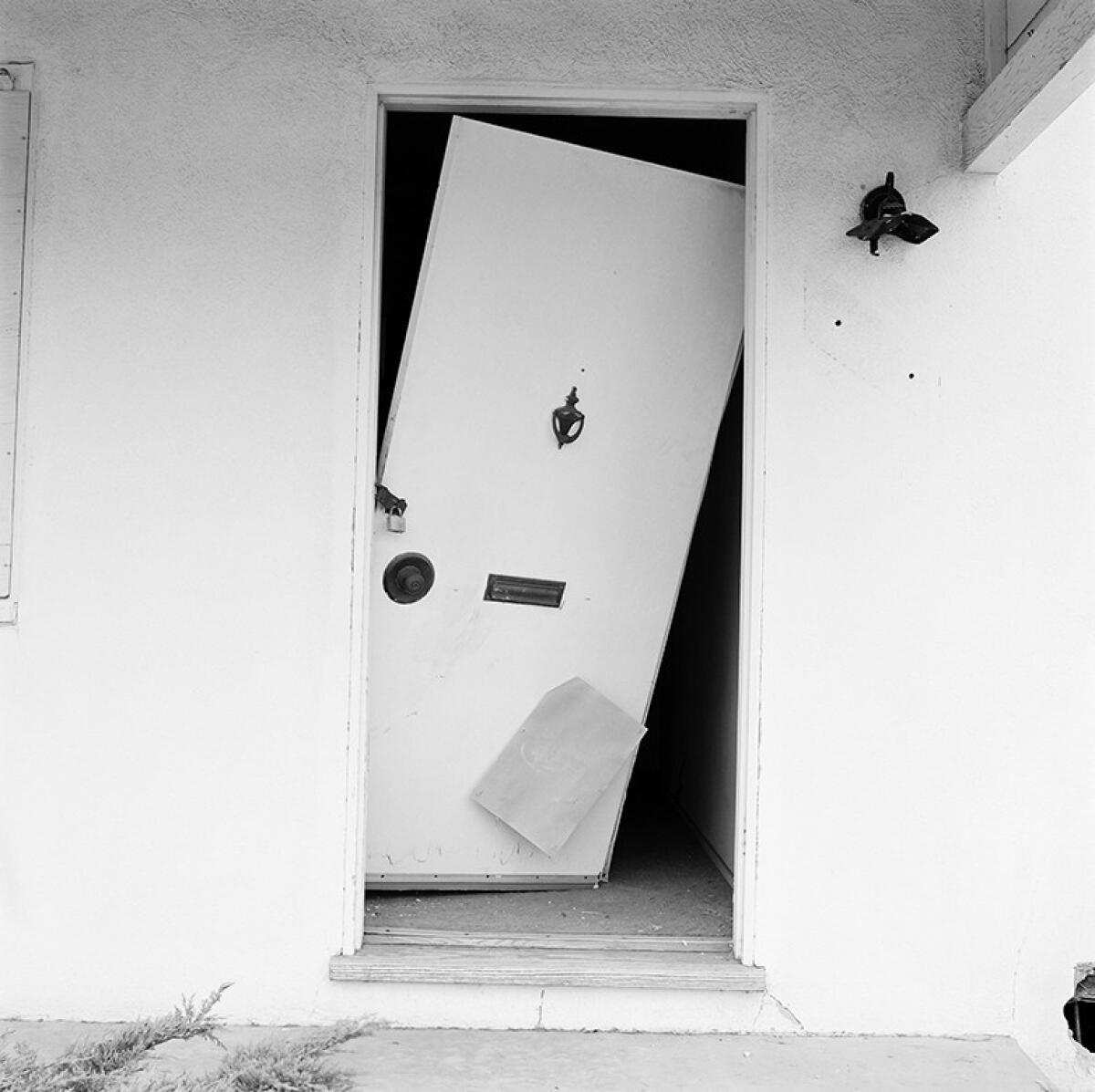
Simone Kennedy Doig and Antonia Showering, at Baert Gallery. A two-artist show features work by a pair of emerging figurative painters: Doig (painter Peter Doig’s daughter) and Showering, both of whom attended the Slade School of Fine Art in London. Through Sept. 22. 2441 Hunter St., downtown Los Angeles, baertgallery.com.
“Philip Rich: Drawings, 1965-1967,” at as-is.la. The Los Angeles artist met with success early in his career, including a solo exhibition at the coveted Ferus Gallery and inclusion in LACMA’s “Five Younger Los Angeles Artists” exhibition in 1965. But mental health issues cut his career short. This show presents some of his extensive production of small line drawings, which often touched on pop and surrealist themes. Through Sept. 22. 1133 Venice Blvd., Pico Union, Los Angeles, as-is.la.

Don McCullin at Hauser & Wirth. The British photojournalist Don McCullin is perhaps best known for his striking war photography — such as his images of grizzled fighters and mourning families in Vietnam. But his range extends well beyond Southeast Asia. He is also recognized for his work chronicling disasters in what was then Biafra (today part of Nigeria), the conflict in Northern Ireland and the ravages of the AIDS epidemic across the African continent. The gallery is bringing together images from various reporting assignments, including Northern Ireland and the construction of the Berlin Wall. Through Sept. 23. 901 E. 3rd St., downtown Los Angeles, hauserwirth.com.
Larry Bell, “Complete Cubes,” and Mary Heilemann, “Memory Remix,” at Hauser & Wirth. The gallery also has two other key exhibitions. The first gathers the ethereal glass cubes made by Bell, a renowned California Light and Space artist whose attention to material, transparency and reflection have earned him a spot in the pantheon of minimalism. Separately, the gallery is showing California-born Mary Heilmann’s first solo exhibition in more than 20 years — a broad survey that brings together paintings, ceramics and furnishings that capture her wide ranging interests, including abstraction, textiles, film and song. Through Sept. 23. 901 E. 3rd St., downtown Los Angeles, hauserwirth.com.

“Entre Tinta y Lucha: 45 Years of Self Help Graphics & Art,” at the Fine Arts Gallery at Cal State L.A. For 45 years, the community arts organization based in Boyle Heights (previously in East L.A.), founded by Sister Karen Boccalero and artists Carlos Bueno, Antonio Ibañez and Frank Hernandez, has supported the work of Chicano printmakers. Since 1973, the print workshop there has produced more than 1,000 art print editions and countless exhibitions. This show presents the work of some of the voices the space has nurtured over the years, including Barbara Carrasco, Enik One, El Mac, Gronk, Delilah Montoya, Judy Baca, John Valadez, Patssi Valdes, Ernesto Yerena and many more. Through Sept. 29. Cal State L.A., Fine Arts building, 5151 State University Drive, Los Angeles, selfhelpgraphics.com and calstatela.edu.
“Pairings: Painters & Sculptors,” at Denk Gallery. A new exhibition pairs the works of a variety of sculptors and painters, such Martin Durazo and Jenn Berger and HK Zamani and Lana Duong, among others. Through Sept. 29. 749 E. Temple St., downtown Los Angeles, denkgallery.com.
Kiff Slemmons, “Collective Presence,” at Craft in America Center. Slemmons is a jewelry-maker who is known for her fabrications in metal but who turned to paper as a material after a stint at the Taller Arte Papel of Oaxaca, a paper studio founded by Mexican artist Francisco Toledo. She has worked with the material ever since, creating one-of-a-kind pieces that employ paper in striking and innovative ways. Through Oct. 6. 8415 W. 3rd St., Beverly Grove, craftinamerica.org.
“In Focus: Expressions,” at the Getty Center. An exhibition drawn from the museum’s permanent collection brings together portraits, figure studies and anonymous snapshots for a keen show exploring the wildly expressive nature of the human face. Through Oct. 7. 1200 Getty Center Drive, Brentwood, Los Angeles, getty.edu.
Barry McGee, “SB Mid Summer Intensive,” at the Museum of Contemporary Art Santa Barbara. A show of the Bay Area artist’s work gathers drawings, paintings and sculptural objects inspired by graffiti, sign painting, hobo markings and other aspects of contemporary urban culture. Plus, it will include a nod to the nearby Reagan Ranch Center. Through Oct. 14. 653 Paseo Nuevo, Santa Barbara, mcasantabarbara.org.
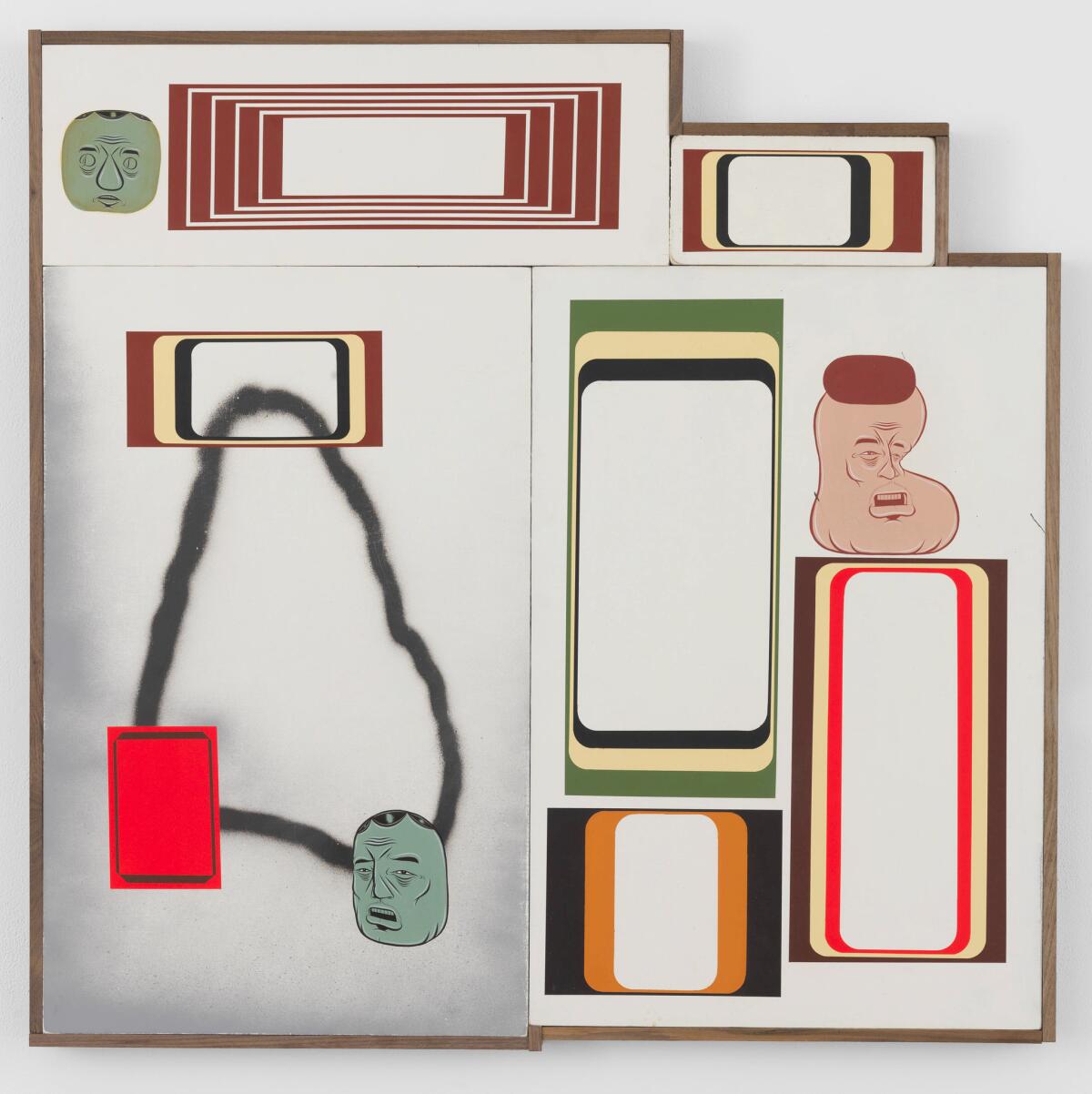
“Icons of Style: A Century of Fashion Photography, 1911-2011,” at the Getty Museum. This exhibition gathers a century’s worth of fashion photography, beginning with images from the early 1900s by Edward Steichen that captured fashion in an “artistic” manner. The survey then goes on to include work by some of the most iconic photographers of the 20th century, such as Man Ray, Richard Avedon, Herb Rittz and Corinne Day. It’s a striking look at fashion, photography and the stories these media can tell. Through Oct. 21. 1200 Getty Center Drive, Brentwood, Los Angeles, getty.edu.
“69: Déjà Vu,” at the Museum of Contemporary Art Los Angeles. This exhibition explores the work of 69, an anonymous Los Angeles fashion designer who frequently works with denim to create garments that could function as movable sculpture, articles that frequently disregard gender, size and race in the way they are constructed and presented. In addition to 69’s designs, the gallery will also be showing the videos and photographs that are used to promote the work — frequently executed in artful ways. Through Oct. 28. Pacific Design Center, 8687 Melrose Ave., West Hollywood, moca.org.

“Line & Color: The Nature of Ellsworth Kelly,” at the Norton Simon Museum. The museum is featuring a suite of 27 color lithographs made by the artist in the mid-1960s, when he was just beginning to experiment with the medium — a challenging one for an artist whose work was based on the seamless, solid expression of color. Accompanying the exhibit are two large-scale paintings from the museum’s collection, as well as preliminary sketches that reveal his working process. Through Oct. 29. 411 W. Colorado Blvd., Pasadena, nortonsimon.org.
“A Handful of Dust: From the Cosmic to the Domestic,” at the California Museum of Photography. Dust permeates the air around us. Dust will bury the cities we live in when we are gone. A group exhibition at UC Riverside brings together images produced over the last century that capture the various aspects of dust. The images are both benign and destructive, featuring the natural world, but also aspects of urban decay. Artists featured include John Divola, Man Ray, Gerhard Richter and Shomei Tomatsu. Through Dec. 9. UC Riverside Artsblock, 3824 Main St., Riverside, artsblock.ucr.edu.
Yunhee Min & Peter Tolkin, “Red Carpet in C,” at UCR Arts. Inspired by the writings of Johann Wolfgang von Goethe, who described music as “liquid architecture” and architecture as “frozen music,” Min and Tolkin have created an installation that fills the UCR Arts atrium with an undulating form constructed out of 150-foot bands of fabric and more than 17,000 colored paper tubes. Through Dec. 29. UC Riverside, 3824 and 3834 Main St., Riverside, ucrarts.ucr.edu.

Judithe Hernández, “A Dream Is the Shadow of Something Real,” at the Museum of Latin American Art. Hernández is known for her work as a painter and muralist; the museum is showcasing more than two dozen of her recent works on paper: dream-like scenes that feature women and wildlife against slightly surreal landscapes. Also on view will be a number of Hernández’s early sketchbooks, as well as the museum’s recent acquisition, her canvas “Les Demoiselles d’Barrio,” a feminist take on Picasso’s 1907 “Les Demoiselles d’Avignon.” Through Dec. 30. 628 Alamitos Ave., Long Beach, molaa.org.
“Striking the Iron: The Art of African Blacksmiths,” at the Fowler Museum. A sprawling exhibition of more than 225 objects will examine the virtuosity of African blacksmiths of the 19th and 20th centuries, who forged iron objects — such as blades, elements of sculpture and musical instruments — that were as aesthetically pleasing as they were, in many cases, functional. Many objects, drawn from the Fowler’s collection, are connected with rituals and the powers of the natural world. This is the debut of this traveling exhibition, which will then go on to the National Museum of African Art in Washington. Through Dec. 30. 308 Charles E. Young Drive N., Westwood, Los Angeles, fowler.ucla.edu.
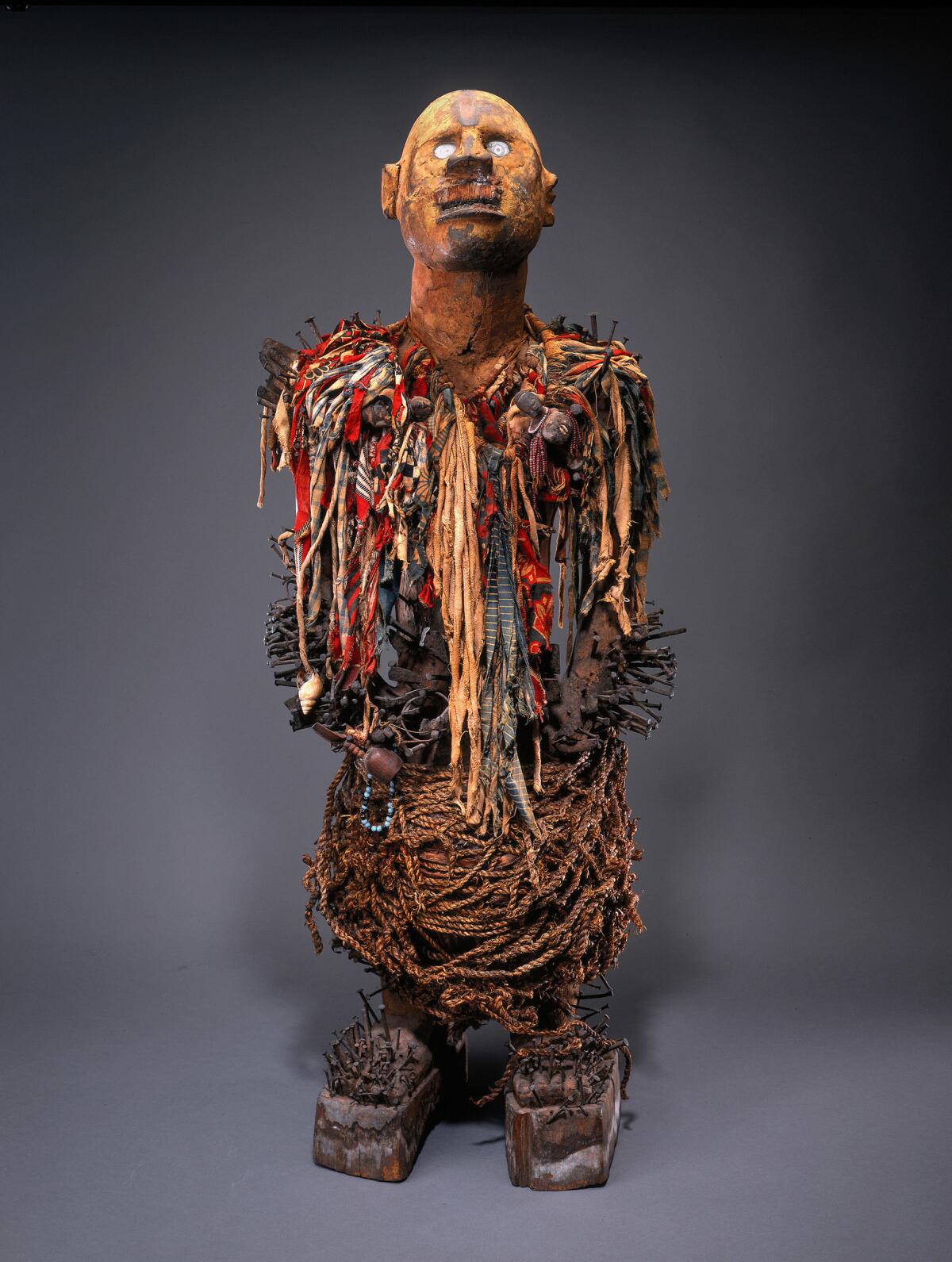
“Gary Simmons: Fade to Black,” at the California African American Museum. In a lobby installation — one that takes full advantage of its size and scale — Simmons pays tribute to forgotten African American actors and films. On a black background, the L.A. artist features the titles and names of films and individuals important to the early days of Hollywood history, but forgotten over time. Through Dec. 31. 600 State Drive, Exposition Park, Los Angeles, caamuseum.org.
“Childhood Left at the Station: A Tribute to the Children of the Kindertransport,” at the Los Angeles Museum of the Holocaust. At the start of World War II, a non-denominational group supported by Jewish, Quaker and other groups called the Movement for the Care of Children From Germany organized to rescue children persecuted by the Nazi authorities in Germany. This exhibition brings together objects from 10 of the estimated 10,000 children who were rescued from Germany — many of whom never saw their parents again. Through Dec. 31. 100 The Grove Drive, Fairfax, Los Angeles, lamoth.org.

Rick Bartow, “Things You Know but Cannot Explain,” at the Autry Museum of the American West. This is the first comprehensive exhibition devoted to the late Oregon-born painter, a member of the Mad River band of Wiyot. Bartow developed a career as an artist later in life — after his service in the Vietnam War and a period contending with PTSD. On canvas, he found inspiration, drawing from historic and contemporary European and Native American artistic traditions to create a fusion of something new: haunting and totemic images of creatures who channel grief and frailty. Through Jan. 6. 4700 Western Heritage Way, Griffith Park, Los Angeles, theautry.org.
“Art of Three Faiths: A Torah, A Bible, and a Qur’an,” at the Getty Museum. The Getty Museum acquired the Rothschild Pentateuch, a manuscript of the first five books of the Torah from the 13th century. It is now putting this rare document on display with other examples of illuminated sacred texts, including a Christian Bible and a Koran. Through Feb. 3. 1200 Getty Center Drive, Brentwood, Los Angeles, getty.edu.

“La Raza,” at the Autry Museum of the American West. In its day, the civil rights publication La Raza, which was based in Lincoln Heights, served as a bible for the Chicano movement, covering protest, policy and everyday life for the Mexican American communities of Los Angeles. Over the years, the paper amassed an archive of 25,000 images, recently digitized by the Chicano Studies Research Center. Many are now on view as part of this PST: LA/LA show at the Autry — and in a time of political strife surrounding the issues of civil rights, this exhibition couldn’t be more timely. Through Feb. 10. 4700 Western Heritage Way, Griffith Park, Los Angeles, theautry.org
“The Archival Impulse: 40 Years at LACE,” at Los Angeles Contemporary Exhibitions. LACE, the historic Los Angeles art spot that gave key shows to Mike Kelley and groups such as Survival Research Laboratories in the ’80s, is turning 40 — and to mark the occasion, the organization has been poking around its metaphorical attic (aka its archive) to see what it might turn up. This show gathers elements from that archive as well as video works by a range of Los Angeles artists, including Jim Shaw, Susan Mogul and Reza Abdoh. Through Feb. 24. 6522 Hollywood Blvd., Hollywood, welcometolace.org.
“A Journey That Wasn’t,” at the Broad museum. A group show drawn from the museum’s collection features work by more than 20 artists whose work dwells on the concept of time and its passage. This includes pieces by Ed Ruscha, Glenn Ligon and Sharon Lockhart and will feature the return of the video installation “The Visitors,” by Ragnar Kjartansson, a charming multi-channel installation that features a group of musicians playing a collective piece while seated in rooms of a decaying mansion. In other words: a welcome break from the news. Through February. 221 S. Grand Ave., downtown Los Angeles, thebroad.org.
“L.A. Communities Through the Eyes of Artists,” in the Passageway Gallery at Union Station. For 15 years, L.A.’s principal train station has been showcasing work that reveals the city through the eyes of its artists. This year, it is showing a series of newly commissioned pieces — including Shizu Saldamando’s depiction of Little Tokyo, Sam Pace on Leimert Park and Artemio Rodriguez on East L.A. On long-term view; no closing date set. Union Station, 800 N. Alameda St., downtown Los Angeles, metro.net.
Daniel Hawkins, “Desert Lighthouse.” The Los Angeles-based artist is obsessed with producing works that toy with ideas of grandiosity, failure and gestures that border on the Sisyphean. (One of his goals as an artist is to ultimately build a scale replica of the Hoover Dam.) Now, Hawkins has installed a 50-foot tall, fully functioning lighthouse in the Mojave Desert in the vicinity of Barstow. The piece even features a light to guide travelers through this rugged landscape. Directions and coordinates can be found on the website. On long-term view, Hinkley, Calif., desertlighthouse.org.
Sign up for our weekly Essential Arts & Culture newsletter »
Twitter: @cmonstah
The biggest entertainment stories
Get our big stories about Hollywood, film, television, music, arts, culture and more right in your inbox as soon as they publish.
You may occasionally receive promotional content from the Los Angeles Times.








